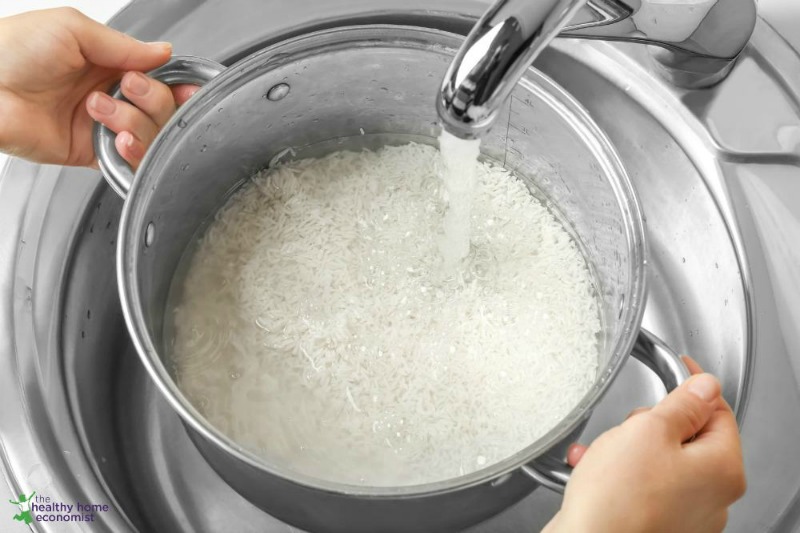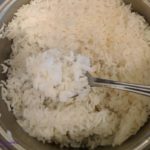Table of Contents[Hide][Show]

Many people I know who follow ancestrally inspired diets assume that soaking white rice before cooking is not necessary. This is because white rice is milled, meaning the husk, bran, and germ have been removed.
While this process removes much of the nutrition, it also renders the rice much more digestible for some people. Some experts go so far as to suggest that white rice is healthier than brown, especially when it comes to maintaining dental and intestinal health.
With primarily just the starch remaining, phytates, lectins and other anti-nutrients present in the hulls are also largely removed.
Hence the very solid reasoning for not soaking it.
Soaking is Not Just for Phytic Acid
I would generally agree with the assessment that within the context of normal, moderate consumption, soaking white rice is not necessary.
But we no longer live in “normal” times when it comes to crop cultivation. Let me explain …
In my early days of traditional cooking, I rarely if ever soaked white rice because our family ate it infrequently. It was mostly starch anyway, right?
However, in recent years, I have taken great care to rinse and soak my white rice before cooking. My reasons have nothing to do with eliminating anti-nutrients.
Nowadays, I soak milled white rice to eliminate toxins most specifically arsenic.
You may already know that arsenic contamination in rice crops is a worldwide problem. This is true even in organically tended rice paddies. This article on arsenic contamination in rice crops outlines the serious situation in detail.
Rice loves arsenic. If there is any present in the soil or water where it is cultivated (arsenic is highly water-soluble), rice crops take it in at a rate ten times higher than other plants! The fact that rice grows in flooded paddies makes the potential exposure to this heavy metal even worse.
Is it any wonder that products made with rice, even organic baby formulas, are testing high in arsenic? The reason is the inclusion of rice syrup as a major ingredient.
The good news is that soaking milled rice in six parts water to one part rice, discarding the soaking liquid, rinsing the rice thoroughly, and then cooking in fresh water significantly reduces arsenic levels by up to 80%. More research is needed, however, to identify how easily different rice varieties give up their arsenic. (1)
Cooking White Rice After Soaking
If you’ve now realized that soaked white rice is the way to go given the global problem of arsenic contamination, the next question is – how to do it?
The book Nourishing Traditions only covers soaking brown rice. My video on soaking grains filmed for the Weston A. Price Foundation only covers brown rice as well.
Warning: if you try to soak white rice first and cook it according to the package directions, it will turn out mushy. I tell you this from experience!
With that, let me share with you my personal recipe for soaking and then cooking up a perfect pot of white rice every time! Tip: this method also works well if you use store-bought or homemade bone broth to cook it instead of filtered water.
The rule of thumb is to reduce the cooking liquid by 1/6 if the white rice has been soaked. For example, if the package instructions say to use 3 cups of water to cook 2 cups of rice, then reduce the water to 2.5 cups. This roughly compensates for the amount of water taken in by the rice as it soaks.

Soaking and Cooking White Rice Recipe
How to soak and cook white rice so that it turns out light and fluffy every time. Recipe uses some bone broth to enhance nutritional profile and flavor considerably.
Ingredients
- 2 cups white rice basmatic rice is recommended
- 13.5 cups filtered water
- 1 cup bone broth
- 2 Tbl butter
Instructions
-
Rinse white rice and place in a large pot. Add 12 cups of filtered water.
-
Stir until the rice is completely wet and settles to the bottom of the pot. Cover and leave on the counter for 4-6 hours or overnight.
-
Drain rice thoroughly in large strainer. Rinse one more time.
-
Rinse soaking pot with clean filtered water and put soaked rice back in.
-
Add 1.5 cups fresh filtered water , 1 cup of bone broth, and butter. Stir.
-
Bring uncovered pot to a boil. Stir once or twice, reduce heat to medium/low and cover.
-
Cook for 13 minutes. Crack lid and see if all the water has been absorbed. If not, replace cover and cook for an additional 2-3 minutes or until remaining water is absorbed.
-
Remove from heat, leaving the lid on. Let sit on the counter for 10 minutes to steam.
-
Remove lid and fluff with a fork. Serve.
-
Refrigerate leftovers once the rice is fully cooled to room temperature.
Recipe Notes
I love serving classic beef stew over soaked white basmati rice.








We use a steamer to cook rice. How do we cook white rice in a steamer that has been soaked?
I don’t have a rice steamer, so have not tried that to know for sure.
Sarah, you once posted an article that gave instructions for removing a certain amount of arsenic from rice…for first cooking white rice for a minute or two then emptying the water, rinsing the rice and then reboiling it to fully cooked.
Do you still go by this method of reducing the toxins like arsenic in rice? I tried to find it on your site here, but can’t find it… Thanks!! Geri
Here’s the article I think you are referring to. https://www.thehealthyhomeeconomist.com/parboil-rice-remove-arsenic/
Both methods will remove arsenic. The extended soak works better for removing the most arsenic. However, a parboil on busy days will remove nearly as much but will not produce the same level of digestibility.
Why is so much water needed for the soaking?
My parents back home still eat partially milled rice which is in between brown and white rice. It tastes sweet and filling and work great for constipation.